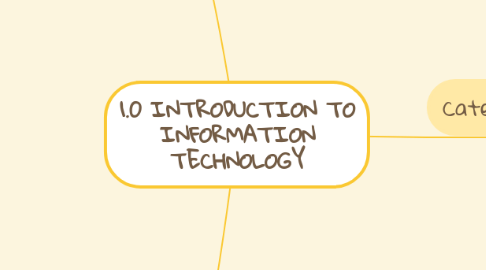
1. Explain Information Technology
1.1. Definition
1.1.1. The use of computer hardware and software to store,retrieve, and manipulate information.
1.2. Advantages
1.2.1. Globalization
1.2.1.1. brought down barriers of linguistic and geographic boundaries by sharing ideas online
1.2.2. Effective Communication
1.2.2.1. communication
1.2.2.1.1. faster
1.2.2.1.2. more efficient
1.2.2.1.3. less cost
1.2.3. Cost Effective
1.2.3.1. pay less for the cost of labour
1.2.3.1.1. use machine
1.2.4. More convenient to shop
1.2.4.1. can do online shoppimg
1.2.4.2. anytime and anywhere
1.2.4.3. lazada,zalora,amazon
1.2.5. Creation of new jobs
1.2.5.1. new employment opportunities created
1.2.5.1.1. Computer programmers
1.2.5.1.2. system analyzers
1.2.5.1.3. hardware developers
1.3. Disadvantages
1.3.1. Unemployment
1.3.1.1. job could be done by machine
1.3.2. Privacy
1.3.2.1. information stored online might be exposed to the public
1.3.3. Cyber Sickness
1.3.3.1. no communication in real life
1.3.3.2. addicted to social network
1.3.3.2.1. facebook
1.3.3.2.2. Twitter
1.3.4. Dominant culture
1.3.4.1. influence teenagers especially
1.3.4.1.1. how they act
1.3.4.1.2. dress
1.3.4.1.3. behave
1.3.4.2. one culture dominate the weaker ones
2. Applications of Information Technology
2.1. Education
2.1.1. Educators and teaching institutions use technology to assist with education
2.1.1.1. Learning Management System
2.1.1.2. Computer Based Training (CBT)
2.2. Finance
2.2.1. Use computer to help manage their finance
2.2.1.1. Online banking
2.2.1.2. Online Investing/ Finance Investment System
2.2.1.3. Loan Processing System
2.3. Government
2.3.1. To provide citizens with up-to-date information
2.3.1.1. e-filling
2.3.1.2. JobsMalaysia
2.3.1.3. Saps
2.3.1.4. UPU
2.4. Health Care
2.4.1. The medical staffs around us are using computers for various purposes
2.4.1.1. Medline
2.4.1.2. Patient Registration Stystem
2.4.1.3. Hospital Management System
2.5. Science
2.5.1. All branches of science use computers to assist with collecting,analyzing, and modelling data.
2.5.1.1. Cochlear Implant
2.5.1.2. Hawk-eye Officiating System
2.5.1.3. Simulation
2.6. Publishing
2.6.1. To make work from publishers of books, magazines, newspapers, music, film and video make their work available online
2.6.1.1. Online newspaper
2.6.1.2. Online magazine
2.6.1.3. Online photo printing
2.6.1.4. Online card printing
2.7. Travel
2.7.1. Can reserve car, hotel and flight by using websites
2.7.1.1. Air traffic controller
2.7.1.2. Airline reservation system
2.7.1.3. Hotel reservation system
2.7.1.4. Intelligence Transportation System (ITS)
2.7.1.5. Car Navigation System by Global Positioning System (GPS)
2.8. Manufacturing
2.8.1. The use of computer to assist with manufacturing processes
2.8.1.1. Computer aided manufacturing (CAM)
2.8.1.2. Computer aided design
3. Guidelines
3.1. Anything goes!
3.2. No criticism or flaming allowed
3.3. The Wilder The Better
3.4. Quantity is Quality
3.5. Set a Time Limit
4. Categories of Computers
4.1. Supercomputers
4.1.1. The fastest,most powerful and most expensive computer that is capable of processing many trillions of instruction in a single second
4.1.1.1. large scale simulation and applications in medicine
4.1.1.2. online banking
4.1.1.3. automotive design
4.1.1.4. aerospace
4.1.1.5. weather forecasting
4.2. Mainframes
4.2.1. A large ,expensive, powerful computer that can handle hundreds or thousands of connected users simultaneously
4.2.1.1. hospital
4.2.1.2. universities
4.2.1.3. large bussiness
4.2.1.4. banks or insurance company
4.3. Personal Computer
4.3.1. Is a computer that can perform all of its input,processing,output and storage activities by itself.
4.3.1.1. desktop
4.3.1.1.1. design to be in a stationary location, where all of its component fit on or under a desk or table
4.3.1.2. notebook
4.3.1.2.1. a potabale ,personal computer often designed to fit on your lap
4.4. Mobile Computers and Devices
4.4.1. M. cOmputer
4.4.1.1. a portable computer designed so user can easily carry it from place to place
4.4.1.1.1. notebook
4.4.1.1.2. tablet
4.4.2. M. Devices
4.4.2.1. computing small device small enough to hold in our hand
4.4.2.1.1. smart phones
4.4.2.1.2. digital camera
4.5. Embedded Computers
4.5.1. Is a special-purpose computer that functions as a component in a larger product.
4.5.2. everywhere around us

